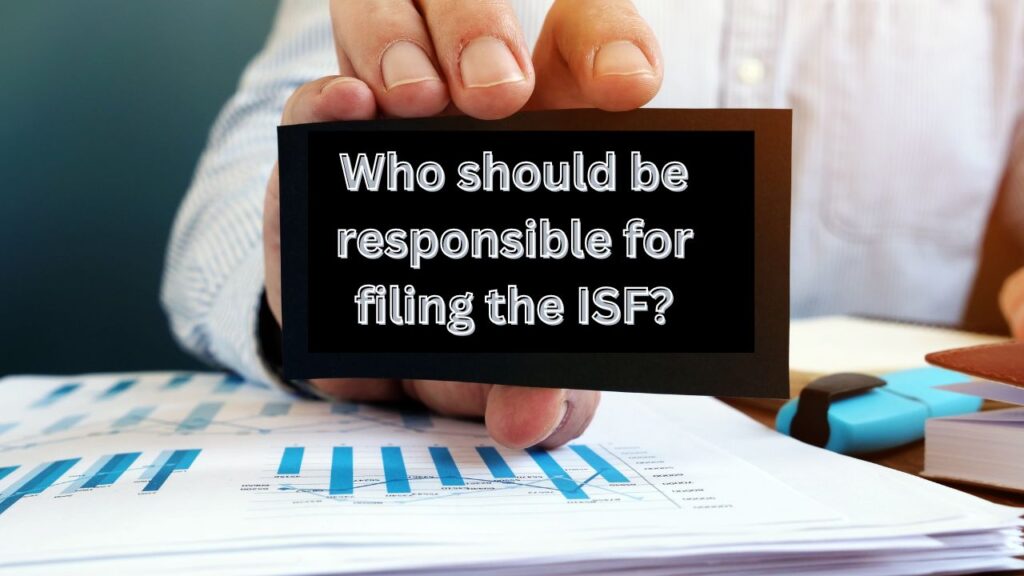The ISF (Importer Security Filing) and Additional Carrier Requirements regulations were implemented in 2009 as an interim final rule to increase CBP’s capacity to recognize high-risk shipments to stop smuggling and enhance cargo safety and security. The Ocean Transportation Security Act of 2002, as amended by Section 343 of the Trade Act of 2002 and Section 203 of the SAFE Port Act of 2006, are both complied with by these regulations. The party that must submit the ISF is the ISF Importer.
What is Importer Security Filing (ISF)

The abbreviation ISF stands for Importer Security Filling. It’s also referred to as ISF 10+2. It must be filed to pass U.S. customs. Importer Security Filing is a requirement of U.S. Customs and Border Protection (CBP) that is particular to imports of sea transport. Importers are required to give CBP advance notice of the cargo information. At least 24 hours must pass before the products are loaded onto the cargo ship for the trip to the U.S. The term “10+2” refers to the ISF’s requirement for 10 data items prior to the loading of cargo and for 2 additional elements at least 24 hours before the ship docks at a U.S. port.
Types of Importer Security Filing (ISF)

Import security filings generally fall into one of two categories.
ISF 5+2: Foreign importers who bring FROB (freight remaining on board) goods into the United States must submit an importer security filing-5. Before arriving at their final destination of arrival to the foreign port of unlading. This also probably applies to shipments made by T.E. and I.E., The imorter security filing (ISF) 5 must be submitted 24 hours before loading at the export country. If ISF 5 is not submitted on time, CBP has the authority to impose fines and penalties starting at $5,000 per instance and rising to $10,000 overall if numerous infractions within a shipment are discovered.
ISF 10+2: By a recent law known as “10 + 2,” importers and carriers must provide U.S. Customs and Border Protection with specific information regarding ocean cargo in advance. “10 + 2” refers to the 10 data items that importers must supply and the 2 data components that carriers must submit. Before loading cargo aboard an ocean ship with a destination in the United States or transit through the country, carriers and importers must provide CBP with the required information at least 24 hours in advance.
Why is it important to fill an ISF?

The data in the import security filing helps CBP better identify high-risk cargo that can endanger safety after arrival. To ensure safety, the importer security filing notifies the CBP when high-risk goods are coming. This improved visibility assists CBP in combating the smuggling of goods and people across the U.S. border.
Who should be responsible for filing the ISF?

Primary accountability for submitting the ISF lies with the Importer of Record (IOR). These importers must also ensure that any duties are correctly calculated and paid on time. However, the IOR frequently delegated this duty calculation and payment responsibility to a broker or freight forwarder who would file the paperwork on their behalf. The importer security filing importer is typically the goods’ owner, buyer, consignee, or agent, such as a certified customs broker. The ISF Importer is the carrier for foreign goods that is still on board (FROB).
What information should fill on the ISF form?

The importer or supplier must provide the following 10 data items on the importer security filing form:
- Location for container loading
- Name and location of the consolidator (loader).
- Name of the buyer and address
- Address of the manufacturer (or supplier)
- Name of the seller and address
- Name and address of ship-to
- Foreign trade zone application identification number/importer of record (IOR) number
- Each product on the package has an H.S. code.
- Consignee Number.
- Nation of origin
The carrier must provide the following 2 data elements:
- ship stow strategy
- updates on container status
When is ISF filing needed for importers?

The ISF filing only applies to the imports of ocean freight shipments. ISF filing does not affect imported cargo using other modes of transportation to enter the United States. Furthermore, bulk cargo is not covered by the ISF. The ISF’s goal is to give CBP agents visibility into all inbound cargo to analyze possible risks and take the necessary action. CBP inspectors can undertake a more extensive assessment of the cargo and the ship when it arrives if the filed ISF demonstrates that the cargo originated from a region with significant political turmoil or contains items that could threaten public safety.
This is why the ISF’s 24-hour submission deadline while loading the cargo. Ahead of investigating high-risk shipments, CBP needs time to prepare given the volume of ships and cargo now transiting U.S. ports. Importers risk having their shipment delayed or denied entry if they don’t finish and submit their ISF on time, resulting in a considerable loss of revenue. CBP may impose fines of up to $5,000 per violation for any erroneous, inadequate, or late filing.
How to Submit ISF to CBP?

When you’re prepared to submit an importer security filing, there are a few procedures you must have to follow. You have the choice of completing these tasks alone or with a customs broker’s help. Just be sure to follow each step precisely to prevent penalties for providing inaccurate information.
Step 1: Assemble all the necessary data
Finding all of the necessary information is the first thing you must conduct. This comprises details about the parties involved in the transaction; the seller and the buyer, the HTS code, the origin country, and other details for each commodity.
Step 2: Create an ACE Portal Account
You must register for an account on the ACE (Automated Commercial Environment) Portal if you don’t already have one. Importers must use the ACE Portal to complete all tasks necessary before, during, and after the importing process, including:
- Submit Protests
- File ISFs
- Complete CBP forms, among other things
Step 3: Submit ISF Online
A CBP-approved third party or the Automated Broker Interface (ABI) in the ACE Portal can be used to do this. After creating an account, you can utilize the interface to enter all the necessary data and submit the import security filing. Customs brokers can file the ISF on your behalf if you use them.
Step 4: Track the Progress of Your ISF
After sending your importer security filing to CBP, you should monitor it to ensure it was approved or fix any errors that led to its rejection. Working with a customs broker has the added benefit of allowing you to have them keep an eye on the progress of your importer security filing- ISF. They can notify you or take care of any problems on your behalf if they arise.
What will happen if Incorrect information is filed on ISF?

There is a $5,000 liquidated damage limitation on inaccurate importer security filing-ISF submissions. Still, CBP will exercise some margin for error if the importer has taken steps to “check the facts to them as much as is commercially feasible. Error-filled submissions might be edited. ISF entries made after the deadline will suffer liquidated damage of $5,000. Importers are urged to provide provisional data, and CBP will keep collaborating with late filers to find solutions to timeliness problems.
Can the ISF form be amended?

The proposed amendments to the Importer Security Filing (ISF) regulations have been made by the U.S. Customs and Border Protection (CBP).
- For shipments transiting in bond to the port of export, data must be supplied no later than 24 hours before the cargo is loaded onto the ship at the foreign port.
- Only circumstances before the products’ initial arrival at a U.S. port require carriers to provide container status messages.
- Before the commodities enter the boundaries of the United States, the ISF must be updated. After the goods arrive in a U.S. port, the ISF may be amended at any time.
How much does ISF cost?

Custom brokers or forwarders charge a nominal fee for their services. The ISF filing price, however, ranges from $30 to $50. Most brokers and forwarders include this expense in the price of an ISF bond. The total here ranges from $80 to $160.
Mainly An ISF filing’s price is determined by two things:
- The number of import shipments or shipments you use.
- Whether you decide to have an ISF filing service provider finish and submit your ISF on your behalf.
It is preferable to pay a lower fee to meet the filing date. This price includes housing that satisfies the ISP’s advanced cargo reporting specifications. Brokers gather this data through intent-to-ship letters or commercial invoices.
What is the deadline to file an ISF?

The ISF Filing Deadline is 24 hours before loading cargo on a ship destined for the United States. The CBP has set and will enforce this deadline. Financial fines, delayed goods, and further inspections may occur if the deadline is missed.
Conclusion
The Importer Security Filing(ISF) and Additional Carrier Requirements regulations were implemented in 2009 as an interim final rule. By these requirements, specific cargo data must be given to CBP via an Importer Security Filing (ISF) before the cargo is loaded onto a ship bound for the U.S. It is the responsibility of the ISF Importer to submit the ISF. Your ocean shipments go through a customs process called an ISF step, and timely filings will assist your business’ import process to go smoothly.
Need help filing the importer security filing form? Contact us now.





